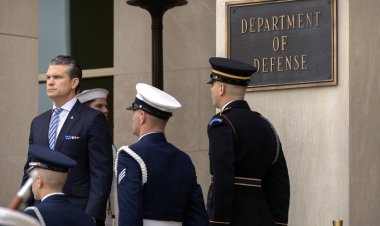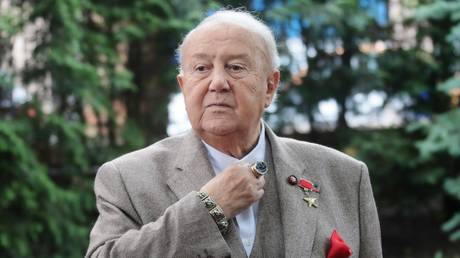Vindman leads new push to send military contractors to Ukraine
The Trump impeachment figure is raising money to help with vehicle and weapons repairs on the front lines.


A group of former military officers and private donors is raising money to send Western mechanics close to the Ukrainian frontlines, where they will repair battle-damaged donated weapons and vehicles that have been flooding into the country.
Leading the group is a familiar name in American politics: Alexander Vindman.
The retired Army officer played a central role in then-President Donald Trump’s first impeachment hearings by testifying about the president’s 2019 phone call with Ukrainian President Volodymr Zelenskyy. During the call, Trump pushed Zelenskyy to investigate the son of then-candidate Joe Biden, Hunter, and his business ties in the country, and was accused of using U.S. military assistance as a lever.
As a private citizen over the past year, Vindman watched the slow Russian buildup along Ukraine’s borders and, he said, became concerned about how Kyiv would support and sustain a long conflict. Vindman and his twin brother Yevgeny, also an Army officer, were born in Ukraine and immigrated to the U.S. as children.
Since the invasion last year, the Biden administration has approved hundreds of Bradley fighting vehicles, Strykers, Humvees, mobile howitzer systems and now Abrams tanks for shipment to Ukraine. But those machines must be taken from Ukraine to Poland or other NATO countries for major repairs, costing Ukrainian forces weeks as they wait for their armored vehicles to come back.
“We've got all sorts of resources going into depots and advanced bases in Poland, mainly, and inside Ukraine basically they're on their own,” Vindman said in an interview. It’s something he hopes to change in the coming weeks if the money, the support and the workers can be lined up.
Right now, for minor repairs and basic maintenance, Ukrainian troops can call American troops on standby in Poland who can walk the Ukrainians through repairs via secure telephone and video links, a process the Pentagon says is working well.
But it’s not a panacea for all the problems, with battle damage and wear and tear as howitzers and vehicles are ridden to their breaking points in hard combat. The government in Kyiv has welcomed virtually all Western help, and with the new influx of more advanced equipment just before what is expected to be another spring and summer of brutal fighting, the experienced hands close to the front could help keep that equipment in the fight.
Vindman's group has secured enough private funding to launch a pilot project in March, and has some backing from at least one company, which declined to be named but confirmed to POLITICO their interest in getting parts and material to Ukraine for more rapid repairs.
The plan is to find 100 to 200 experienced contractors who would travel to Ukraine and embed themselves with small units near the front lines. Under the project, called Trident Support, those contractors would in turn teach the Ukrainian troops how to fix their equipment on the fly.
The Biden administration has long tried to dissuade Americans from going to Ukraine, but private efforts like this are still possible with the blessing of the Ukrainian government. There is also a pool of thousands of non-American mechanics qualified to work on U.S. and NATO equipment who could be recruited.
The presence of U.S. citizens on the ground providing military logistics support would likely be a new irritant to the Kremlin, and any injuries, deaths, or capture of Americans by Russian forces would be a black eye for the White House as it works to keep congressional support for arming Ukraine. Yet the amount of foreign equipment pouring into the country — with more expected — means taking some risks in order to keep that machinery humming.
“There is absolutely a way to do this and secure American contractors or Western defense contractors in-country,” Vindman said. “You could do this using what we call ‘third country nationals’ where it's not American.”
There are already a handful of contractors working on systems donated by their countries inside Ukraine, but those Polish and Czech mechanics are relatively few in number and go for short stints only.
“The biggest challenges are that the U.S. government currently is deeply reluctant to put defense contractors on the ground,” Vindman said. “That means that people are getting paid to repair stuff in Poland, but that doesn't satisfy the warfighting capability of the Ukrainians. So this would be a kind of a policy change.”
There is no talk of trying to replicate the massive effort the U.S. ran in Iraq and Afghanistan, where at times there were more contractors fixing vehicles, cooking food and running communications systems than troops doing the fighting.
“If you're doing this smartly, and you're distributing five or six facilities [in Ukraine], you could do this for about 150 to 200 mechanics,” spread out at various locations across the front, Vindman said.
Part of the reason for the smaller-scale operation is the fact that any large depot with a visible manufacturing capability would be an obvious target for Russian drones and artillery. Russian strikes hit the Ukrainian manufacturing sector hard in the opening weeks of the war, particularly plants focused on the defense industry.
Another is the simple problem of throughput. Material is stacking up in Poland at repair facilities, and it’s much harder to get that equipment over the border in significant quantities on a regular basis, given the limits of trucking and rail capacity.
One employee of a non-profit organization in Ukraine who has done similar work in other conflict zones said that in Ukraine, “it's a really complex system and the structure for tracking logistics is spread very thin right now because they're fighting."
“I do not see the large logistics companies that have had experience in other areas transporting stuff in and out, or really helping out on that level in Ukraine,” said the person, who requested anonymity due to ongoing contracts in Ukraine.
Doing that work inside Ukraine could save time and start the process of getting the Ukrainians up to speed on fixing equipment that the country will likely need to maintain for years to come.
“It's complicated, but not an intractable problem,” said Ken Letcher, a retired Army colonel who specialized in logistics. The U.S. spent two decades in Iraq and Afghanistan supplying equipment across the globe and training locals to do the work for themselves.
Letcher is helping on the project, which he said is seen as “a fairly finite requirement of 12 to 18 months. At some point either after the Ukrainians are caught up on maintenance, this capability would stand down, or at some point after the war, it is then handed over.”
While some of the larger, more complicated work will still have to be done in large depots in Poland and the Czech Republic, “in the meantime the Ukrainian army needs to create such a hub in Ukraine itself,” said Mykola Bielieskov, a research fellow at Ukraine’s National Institute for Strategic Studies.
“Since we managed to create [Humvee] maintenance in Ukraine with the involvement of private funds, the next level of maintenance is something we might dare to do in future,” with other vehicles and weapons systems, he said.
Vindman, for his part, said that while the repair project is a philanthropic effort at the moment, “this may become a viable business with government support."
“But we aren’t holding our breath or waiting for permission,” he added.












